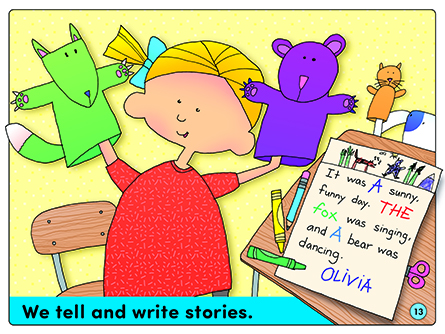Additional Activities
These activities offer options for continuing the learning in this unit. Whether your curriculum is skill-based or more open-ended, select the activities that are most appropriate for the children in your classroom. The Writing Spot is primarily a writing program, but writing can be integrated throughout your curriculum—in art, drama, reading, math, and science.
Read stories with sounds to your class. Invite them to join in the storytelling by reading a key group of words or adding a sound in appropriate spots. Make a list of “sound” words (boom, crash, howl, splash, drip, buzz, snap, woof, meow) for children to use. Encourage them to write stories with sounds that they can read aloud to the class. Try "Night Sounds" as a read aloud.
-
Invite a storyteller to visit your class.
Invite an experienced storyteller to your class—one who will involve the students in the stories.
-
Young writers benefit from working with mentors.
Plan a day (or a week) when older students come to work with your young students on a writing project. Direct the older students to assist as needed by adding letters or words that the children cannot yet write. The mentors must be encouragers, without taking over the ideas and plans for their young friends. Make the project sufficiently involved to require assistance.
Invite members of a high-school drama team to visit your class. Have them do an impromptu add-on story for the children. One member of the team begins the story and the others contribute until the story ends. Your children can do something similar sitting in a circle and passing an object from person to person. Whoever holds the object contributes the next part of the story. For added structure, divide the circle into the story’s beginning, middle, and ending.
-
Use pictures to tell stories.
Share picture books in a variety of illustration styles with the class. Ask the children how the colors and pictures make them feel. Let the children tell what they think is happening throughout the book, simply by looking at the pictures. Then read the story aloud and compare their version with the real thing. Look online for the home pages of well-known illustrators. Many illustrators and authors have pages on the Internet where children can visit and interact. For more information, check out the Society of Children’s Book Writers and Illustrators.
-
Relate stories using body movements.
Finger plays are one way to help children interact with the words in a story. You can also do a shared writing activity that incorporates “doing” words in the text; then have children act it out—for example: I bounce the ball. The dog grabs the ball. The dog runs away. Also consider asking children to “dance” a story. Read them part of “The Nutcracker,” and show the corresponding portion of the video so they can see how the story is danced.
-
Share stories by singing.
Most songs tell a story. Play some children’s songs, and then have children retell the stories using their own words. Find picture books based on familiar children’s songs and share them with children. Encourage those who are so inclined to write a story and sing it to the class.
-
Stage stories with puppets.
Throughout the school year, explore different kinds of puppets with the children: shadow puppets, finger puppets, stick puppets, paper-bag puppets. Create an impromptu (or more permanent) puppet stage. Drape a curtain over a rope, use a cardboard box, or drape a table big enough to hide behind. Have children tell stories using puppets. Begin with simple, well-known stories like “The Three Bears.” Then have children tell their own stories, using puppets they’ve made. Remind the children that puppet shows can be simple one-character activities, like choosing a puppet to “read” one of their stories to the class.
-
Dramatize stories through plays.
Don’t forget to use peer teachers as resources. A third-grade class from your school, for example, might enjoy performing simple plays for your kindergarten class. Remind your young children to be good, quiet listeners when they are in the audience.
-
Play a story-writing game.
Play a “beginning, middle, and ending game” with the children. You write a beginning and an ending sentence on the board or chart, and the children dictate a sentence to fill in the middle. Repeat the same activity, but ask the children to provide a different part of the story—either the beginning or the ending sentence. Encourage children to play this game in groups of three, with each child contributing a part of the story.
-
Write and tell stories to share at home.
Parents read and tell stories to their children. Ask the children to reciprocate by writing a story to take home and read to their parents or caregivers. As you read and tell stories to your students, remind them to share these with their families.

